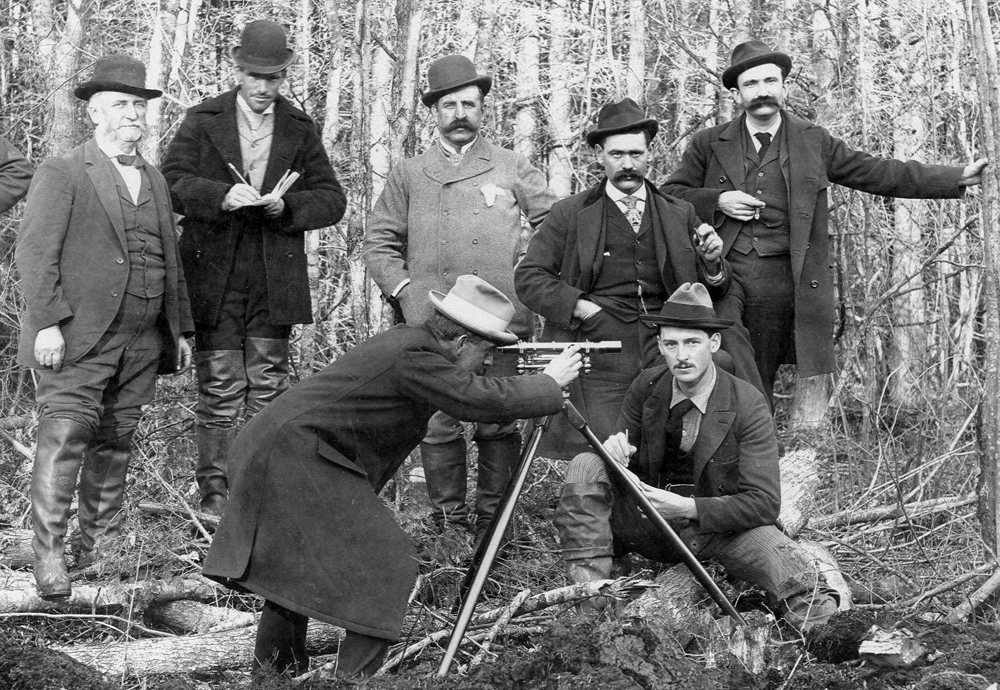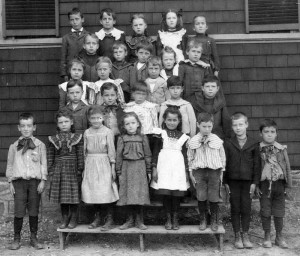True Tales from Canton’s Past: Canton’s Golden Age
By George T. Comeau
The laying of the town’s first water line during Canton’s Golden Era (Courtesy of the Canton Historical Society)
A question was recently posed on Facebook that asked, “What would you consider the Golden Era of Canton?” There were only a handful of answers. Sarah Titus answered, “Now. Schools are great, streets are clean, seniors getting a new clubhouse, new walking trails at the eyesore airport, good things happenin’!” But of course, my answer took a longer view of the town through the lens of a historian.
Taken in totality, the 45 or so years between 1865 and 1911 proved to be a very special time in our town’s growth. And while Sarah Titus certainly lives in the here and now, another writer, Janette Jennison, posted in the same thread a thought back to an earlier time: “Probably the time my grandparents were young, the 1920s or so. From stories I have heard, growing up. Extended family lived within walking distance on Pleasant Street. They grew their own food, which they put up for winter, and shared. My Great Uncle, Bob Shaw, was the egg-man, and delivered through the community. Kids could skate on ponds, and sled and toboggan in the winter. Pick blueberries and blackberries in the summer. I am thankful for my Canton roots. Wish all kids could grow up in a carefree world…”
The Gilded Age is a term that in United States history covers approximately the final three decades of the 19th century, from the end of the Reconstruction Era in the 1870s to the early 1900s. This was an era of rapid economic growth, especially here in the north. And in Canton, so too as the nation grew, we were in our own Golden Era.
The Civil War had an amazing effect on our community. In the first place, 30 men from our town died in that conflict, and dozens of others fought in faraway places to secure freedom for all. Upon returning home, many of these men formed within the fraternal veterans’ group known as the Grand Army of the Republic. As men grew into prominence they worked hard to establish Canton as a modern and improved place to live.
As early as January 1853 our earliest newspaper, The Massapoag Journal and Canton Observer, wrote a glowing profile of our town. An excerpt reads: “Within the short space of ten years, the number of dwelling houses in the South Village (now Canton Center) of the town has more than trebled. The population has been constantly and steadily increasing, and it is a rare thing to find a man who is out of employment. The Iron Works of Lyman Kinsly, Esq. the Revere Copper Company’s Works, the Neponset Company, and the Shovel Works of Messrs. Ames, the Cutlery Works of Messrs. Reed and Adams, give constant and profitable employment to a large number of men, while the Silk Manufactory of Messrs. Messinger, the Cotton Manufactories of Messrs. Shepard, Kaley, Upham and Mansfield give employment to a great number of females … The traders of Canton are equally enterprising and ambitious. Few country villages can boast of so many well filled stores. All that we have said is true, argues that Canton is a growing place; that her citizens are industrious, frugal, energetic, persevering, enterprising and properly ambitious. Now we are prepared to ask, are we a virtuous people? Are we an intelligent people? Are we a Christian people?”
The stage was set for enormous and unprecedented growth. From a construction standpoint, the Gilded Age in Canton was extraordinary. The veterans of the Civil War had come home in 1865 as changed men, and in turn they would change the town. Not content with simple memorials and antiquated political structures, they took on the challenges of the times — clean drinking water, better schools, improved roadways, buildings that housed social organizations, and of course, some of the finest houses ever built.
One of the earliest examples of this time in our history was the construction of Memorial Hall in 1878. Burned in the memory of the soldiers were their fallen comrades. Beautiful poems and songs were sung for the dead, but how would the ages remember these sacrifices? The answer is still evident today at what is arguably one of the grandest shrines in our county. Place this building in context for its time: The building is massive in scale, made even more impressive when you consider it was built in the late 19th century for a town with a population of approximately 4,000 people. Covering 6,500 square feet, its extreme height is 80 feet above the finished grade. This was the start of building great things.
Less than ten years later, plans were created to construct a water system that would provide clean drinking water throughout portions of the town. Drive down Pine Street and see the Canton Water Works building. The date stone reads 1888 and this Richardson Romanesque style building has similar architectural attributes to that of Memorial Hall as well as a later cousin at the Stoughton Water Works on Central Street.
The planning for a town-wide water system was proposed in 1882 by a fledgling Board of Health. Water-borne illnesses were caused by stagnant wells, polluted waterways, and proximity of outhouses to the water supply. Add to the fact that most households owned cows and other livestock, clean water was a scarcity. In 1885 the Canton Water Act funded the construction of the system, including the pumping station at Springdale. Frederick Endicott, Frank Ames and Charles Galligan became the first members of the Canton Water Commission, and they oversaw the construction of the building at Beaver Meadow Brook. It is a grand design to serve a utilitarian purpose, yet this was a time when beauty and art coexisted with architecture even for the simplest of buildings.
As the town grew, so too did the need for schools. The 1890s brought about the construction of the Ponkapoag School, a remarkable example of Shingle style and one of the last surviving examples in Canton. The new school, which opened in 1893, replaced a small one-room schoolhouse that was wholly inadequate in the estimation of Augustus Hemenway, the leading scion of the Boston Brahmin Hemenway family and notable resident of Green Street in Ponkapoag. It is likely that Hemenway was responsible for not only paying for the new school, but also overseeing the construction — including hiring Franz E. Zerrahn to design the new school.

Canton schoolchildren outside the new Ponkapoag School, circa 1894 (Courtesy of the Canton Historical Society)
Meanwhile, at Canton Corner, a new school was being built in 1894 that would become the Eliot School. This building is notable and historically significant owing to the fact that it is evidence of the population growth tied to the industry of Canton. The Draper Woolen Mills were at full production and the town was burgeoning as a result of a new immigrant population seeking a better life and higher wages. The increase of industrialization meant, despite the increasing labor force, wages grew 60 percent from 1860 to 1890 and continued to rise after that. As a result, a commitment to our youth meant improved lighting, heat, ventilation, and no longer overcrowding in the learning environment.
Here too we see the first difference between public monies versus private monies in construction. The builders of the Eliot School (now the Canton Police Station) chose to forego unnecessary details in favor of a modern school for the least expense. Where Hemenway sought a grand scale project, the town chose a modest building almost completely built by townspeople. J.F. Stone of Canton were the builders; local stonemason Dennis Crimmins laid the foundation along with the bricklayer, John O’Connell. The painter was William Hesketh, and the plumber was George Beasley — all Canton men building for their families’ future.
The building boom continued into the early 1900s. Hemenway was in the habit of giving grand and generous gifts to Canton. By the late 1890s, as the town’s small library outgrew the space in Memorial Hall, it was Hemenway who once again bought land, hired an architect and personally paid for the construction of the spectacular building on Washington Street. On the day it was completed, Hemenway and his wife signed the deed over to the town. Opening in 1902, the new library was a grand gesture in a time of gilded life.
This same period saw the state legislature pass Chapter 446 of the Acts of 1904 — the creation of the Massachusetts School and Home for Crippled and Deformed Children. The name was changed in 1907 to the Massachusetts Hospital School, and buildings commenced. The seed that was planted in 1904 created one of the finest and first schools of its kind in the nation.
Almost as bookends to the period, the Canton Historical Society and the Hemenway School were built in 1911. The industry of the town was in decline, yet these last two examples show how wonderful this era was and how the promise of our youth was still at the forefront of the minds of the townspeople. Again, Hemenway brought significant private funding to the building of the school. And private donors would build what I have always affectionately dubbed Canton’s Attic.
Taken in its totality, for this historian, this was Canton’s Golden Age. All of the buildings in this story still exist and serve as a reminder of our past and importance to the future.
Short URL: https://www.thecantoncitizen.com/?p=26168










